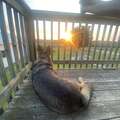Northwestern’s Bicuspid Aortic Valve Program Highlights Trend To Sub-Specialization
By Adam Pick on July 11, 2012
One trend I’ve noticed over the years is that surgeons and cardiac centers are becoming “sub-specialists” specific to heart valve treatment. By sub-specialization, I mean that clinics are extending significant resources to advance valvular therapy by disease type, by surgical technique and by patient risk factors. For example, three weeks ago, I met with a surgeon who suggested that 99% of his procedures are mitral valve repairs.
Last Monday, the trend to “sub-specialization” became more apparent when Chicago-based Northwestern Memorial Hospital launched a dedicated Bicuspid Aortic Valve Program within its distinguished Bluhm Cardiovascular Institute.
Prior to learning about Northwestern’s BAV program, I knew that a handful of surgeons and cardiac centers specialized in bicuspid aortic valve treatment. However, I had yet to hear of a complete, end-to-end program dedicated to bicuspid aortic valve disease — a disorder that impacts 1%-2% of the population.
“Care for patients with a bicuspid aortic valve is complex,” stated Dr. Patrick M. McCarthy, director of Northwestern’s Bluhm Cardiovascular Institute. “This program is the first to support a patient from A to Z, through screening, monitoring, family assessment, treatment and research.”
To manage this unique program, Northwestern called upon leading physicians including Dr. Jyothy Puthumana, Dr. Paul Fedak, Dr. Mark Markel and Doctor Chris Malaisrie. Interestingly, this cross-functional team includes cardiologists, surgeons, radiologists and a dedicated research nurse.
To learn more, I spoke with Colleen Clennon, RN, Bicuspid Aortic Valve Nurse Clinician, at the Bluhm Cardiovascular Institute. Colleen noted, “I’m here to make sure each patient with a BAV is taken care of throughout their entire treatment process.”
Congratulations to Northwestern for the launch of its BAV program! Like many patients in our community, I was born with a bicuspid aortic valve. That said, I believe this approach to specialized treatment will be very valuable for patients and their families — now and in the future.
Keep on tickin!
Adam
|
Debbie Argetsinger says on July 11th, 2012 at 4:14 pm |
|
Now that my bicuspid aortic valve has been replaced with a mechanical valve do I have to be monitored for future aortic problems? I seem to get conflicting information as to whether I am “fixed” or not. As for my children, what is the best test to use to evaluate their valve and aorta and how often should they be tested? Thanks, |
 |
|
cindy says on July 11th, 2012 at 7:12 pm |
|
I was born with BAV, have already had valve replacement surgery. My question is, do my children need to be worried about inheriting this? Have you had Ethan checked? |
 |
|
Jyothy Puthumana says on July 12th, 2012 at 10:48 pm |
|
Debbie, Jyothy Puthumana MD |
 |
|
Jyothy Puthumana says on July 12th, 2012 at 10:58 pm |
|
Cindy, The AHA/ACC Adult Congenital Heart Disease Guidelines recommend screening of all children of patients who have been identified with a BAV. Jyothy Puthumana MD |
 |
|
Erwin says on July 31st, 2012 at 9:08 am |
|
I am 38 yrs old . Yesterday, I have an echo done and found that my aorta is so dilated and that I also have a bicuspid aortic valve. Now I am to undergo an aortic root repair/ graft and aortic valve replacement…. I am confused of whether I will choose mechanical vs. pig / bovine valve. Please help me decide……also, with the surgery that I am gonna have, do I have risk of redeveloping another aortic aneurysm? Thank you for your response. |
 |
|
Colleen Clennon, RN says on August 7th, 2012 at 2:04 pm |
|
Erwin, Colleen Clennon, RN, BSN, CCRN |
 |
|
Carlie says on March 11th, 2013 at 1:27 am |
|
Hi there! My husband was born with a BAV, and has had the Ross Procedure done. He also had an aneurysm in his aorta. I was just curious, what are the chances of our children inheriting it? Also, if they are checked and do not have the BAV, should they be monitored for aneurysms? I am hearing a lot of different things, and I am very concerned. Thank you so much for any answers you can give me! |
 |
|
Colleen Clennon, RN says on March 11th, 2013 at 12:48 pm |
|
Carlie, As Dr. Puthumana stated above, “The literature on the likelihood of transmission seems to suggest that the risk of a child inheriting it may be in the 10 % range.” There aren’t any official guidelines for children on aorta screening other than the initial screening echo. I did check with my colleague at Lurie Children’s Hospital and their standard is if the initial screening echo is normal and they are not yet adult sized they would repeat the echo at regular intervals to check for aortic dilatation. This may be a conservative approach, but it’s their practice so as not to miss anything. If you have other questions you can contact me directly at bav_rn@nmh.org and I can get you in touch with Lurie Children’s. |
 |
|
Carlie says on March 11th, 2013 at 2:14 pm |
|
THANK YOU SO MUCH FOR THE INFORMATION! I truly appreciate your help! |
 |














